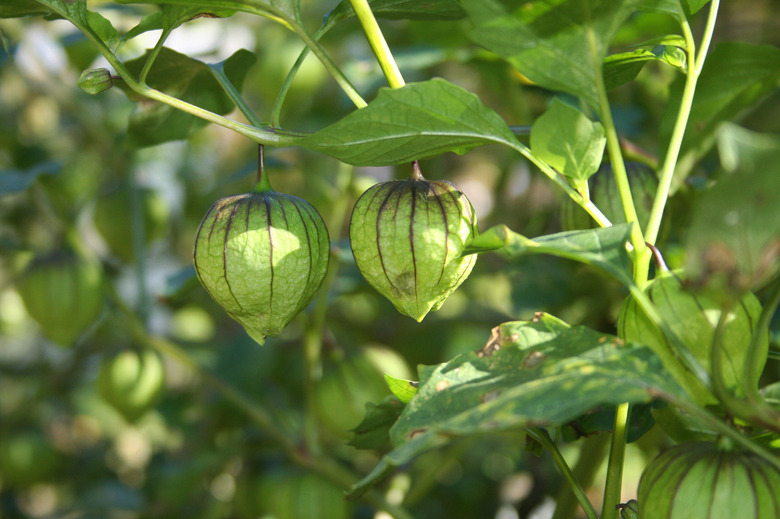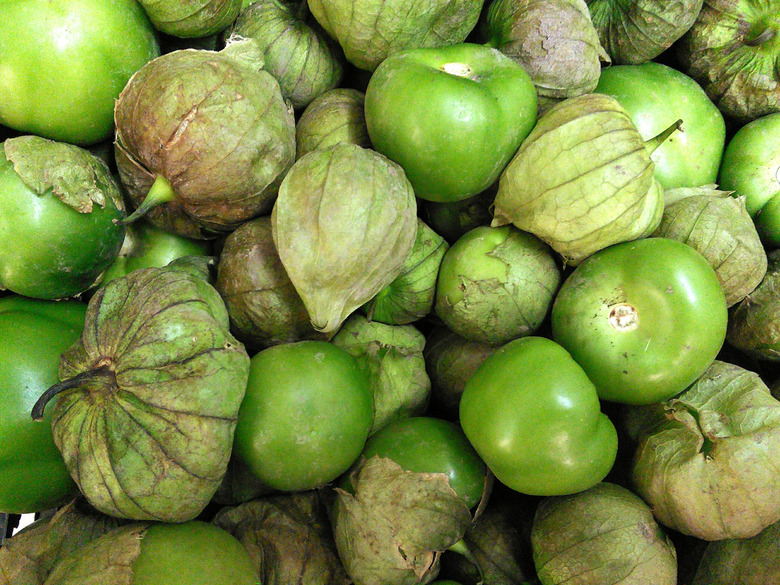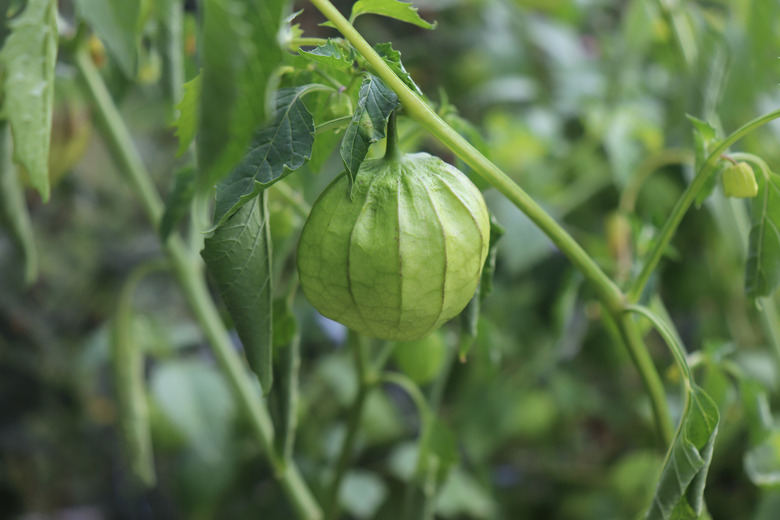How To Grow Tomatillos
We may receive a commission on purchases made from links.
If you've had the pleasure of experiencing authentic Mexican cooking, you know that tomatillos (Physalis philadelphica) have a zesty tang like no other. Their name may mean "little tomato" in Spanish, but tomatillos taste nothing like their tomato cousins.
A single tomatillo plant can produce 2 or 3 pounds of 1- to 1.5-oz. fruits during a single growing season. You'll need to grow at least two plants to ensure proper fertilization and fruit set.
Best Uses for Tomatillos
Best Uses for Tomatillos
With a unique tangy yet sweet citrus flavor, tomatillos form the base of many Mexican sauces, like salsa verde. Gardeners plant them to keep a steady supply of this unique fruit during the growing season. As the season winds down, tomatillo lovers freeze the fruits themselves or a puree made from them to enjoy in recipes during the winter.
Tomatillos do resemble a green tomato when removed from their husks, but don't let that fool you. Tomatillos make a great addition to many Southwestern dishes, but they taste nothing like green tomatoes as Americans (particularly Southern Americans) know them. A good rule of thumb: Never attempt to substitute a tomatillo in a recipe that calls for a green tomato and vice versa.
How to Plant Tomatillo Seeds
How to Plant Tomatillo Seeds
Sow the seeds about 1/4 inch deep after working a bit of aged compost into your soil. Space your seeds 2 to 4 feet apart to give your tomatillo plants adequate growing space. These plants are prone to sprawling, so leave them plenty of room to stretch their legs.
If you're working with limited space, sow your tomatillo seeds next to radishes, lettuce, and other cool-season vegetables that you'll harvest early. This will allow your tomatillos the room they need while maximizing your garden real estate. By the time your tomatillos grow tall enough to impact your cool-season veggies, you will have already harvested them and cleared them out, leaving plenty of room for your lanky tomatillo plant.
Tomatillos don't easily self-pollinate, so you'll need to grow more than one plant so they'll cross-pollinate each other. The simplest way to do so is to drop two seeds at a time when planting. The two seeds can grow together and resulting plants pollinate each other's flowers.
You can leave tomatillo plants on the ground, but they will sprawl and will prove to be harder to harvest if you do. It's best to trellis your plants or grow them in a tomato cage. The easiest way to do so is to install your cage above the seeds you planted so you can easily coax your seedlings onto the support as they grow.
If desired, you can sow tomatillo seeds in the ground when the danger of frost has passed. Ideally, tomatillos like nighttime soil temperatures no lower than 60 or 70 degrees.
Tomatillos have a long growing season of 75 to 100 days. To speed your summer harvest, you can start seeds in indoor seed trays six to eight weeks before the last frost. If you do, harden off your seedlings before transplanting them.
How to Plant Tomatillo Seedlings
How to Plant Tomatillo Seedlings
Home gardeners typically grow tomatillos from seed, but you can buy seedlings at the garden center if you live in an area where they're popular. Seedlings can go into the ground when any danger of frost has passed, and you plant them the same way you plant tomatoes. Plant tomatillo seedlings deeply, placing 2/3 of the plant in the ground. Space the plants 4 feet apart and then install a tomato cage over them or place a trellis nearby.
In What Zone Do Tomatillos Grow Best?
In What Zone Do Tomatillos Grow Best?
Tomatillos grow as an annual plant in USDA hardiness zones 6 and warmer, although you can grow them as a perennial if you live in zone 10 or 11. Your tomatillos will do well as long as the temperature is between 80 and 90 degrees during the day and doesn't fall below 60 degrees at night.
Tomatillos relish full sun but do exercise caution. If you live in an area where temperatures in the sun can climb into the triple digits, your tomatillos may appreciate a bit of afternoon shade.
When Should You Plant Tomatillos?
When Should You Plant Tomatillos?
If it's time to plant the tomatoes, then it's time to plant the tomatillos as well. Plant after the last frost when the soil temperatures stay above 60 degrees Fahrenheit at night. Once they get going, tomatillo plants keep producing fruit until the first frost or a sharp temperature dip kills them.
Soil, Sunlight, and Water Recommendations for Tomatillos
Soil, Sunlight, and Water Recommendations for Tomatillos
Tomatillos like evenly moist soil with a pH between 5.5 and 7.3. They need about an inch of water a week, but they don't like wet feet. If your soil is heavy, create a small soil mound and plant your tomatillos on top of it so the water can run off. Tomatillos are mildly drought tolerant, but you'll get more fruit and have happier plants if you don't let it come to that.
To help keep the soil evenly moist, mulch around your plants when they're tall enough. When you water, direct it at the base of the plant rather than its leaves. If you choose to grow your tomatillo plants in a container, check often to see if they need watering since container plants usually need more frequent irrigation than those grown in the garden. A 5-gallon bucket is the perfect size for tomatillos, which should be planted as one plant per container.
Make sure your tomatillos are planted where they can enjoy full sun and have plenty of support. If you didn't install a trellis or tomato cage when you planted your seeds, make sure to do so before your plants become top heavy.
Tomatillos generally don't need enriched soil, so fertilizer isn't necessary. If you do want to fertilize your plants, side-dress them with a 5-10-10 fertilizer. Too much nitrogen will cause leafy plants with few fruits, so avoid adding a lot of it.
How to Propagate Tomatillos
How to Propagate Tomatillos
If you run across a particularly hardy or tasty tomatillo plant, you can propagate it from a cutting to produce a clone. To do so, select a healthy green branch from the parent plant and cut it to a length of 6 inches. Remove any leaves or flowers from your cutting. You can then dip your cutting into a rooting compound if you like, but don't stress if you don't have any. Tomatillo stems form roots easily and may even do so on their own if they lay on the floor of your garden for too long.
You can also place your cutting into a jar of water and wait for it to grow roots. When the roots start to grow, transfer the cutting into a small container of potting soil and keep nurturing it until it's big enough for the garden.
How to Harvest Tomatillos
How to Harvest Tomatillos
Tomatillos are ready for harvest 75 to 100 days after germination. To collect the ripe fruit, pluck your tomatillos from the vine when they've filled in the thin husks that grow around them. When tomatillos are ready, they'll often cause a small split in their husks. Brown leathery husks also indicate that it's harvest time. Baggy husks indicate fruit that isn't ready yet, so leave fruits with loose covers on the vine a bit longer.
When harvesting, remove and dispose of yellowing tomatillos, as these have stayed on the vine too long. Pick up and dispose of any tomatillos that have fallen to the ground as well. If you leave fallen or overly ripe tomatillos in your garden, they're likely to plant themselves as the fruit rots around the seeds. If that happens, you could end up with way more tomatillos than you can handle.
To store your harvested tomatillos, drop them husk and all into a paper bag and toss it in the fridge. The fruit will stay good for two to three weeks. If you want to keep your tomatillos longer, remove the husks and freeze or dry the fruit. You can also freeze tomatillo puree.
Common Pests and Other Problems for Tomatillos
Common Pests and Other Problems for Tomatillos
Tomatillos don't boast any unique pests of their own, but they are susceptible to flea beetles and any other insects that like to munch on plant leaves. Because they're such vigorous growers, however, insect damage usually amounts to nothing more than a cosmetic issue.
If the insects bother you, pick them off by hand, shoot them off with the garden hose or apply an insecticidal soap to your plants.
Common Diseases for Tomatillos
Common Diseases for Tomatillos
Luckily, tomatillos don't have many pest issues and they also don't suffer from any distinct illnesses. Like all leafy plants, fungi and bacteria can pose a problem if the plants grow too close together or if you don't rotate your crops. If you do notice any spots or rots, apply a product designed to kill both fungi and bacteria.
The exception to this is mosaic viruses. There is no cure for viruses, which cause plant leaves to curl and develop yellow or white streaks. If you see signs of a mosaic virus, remove and destroy the affected plant promptly.


